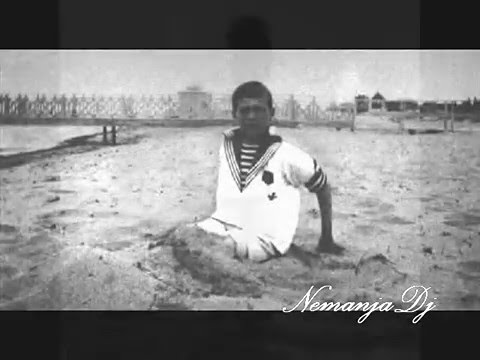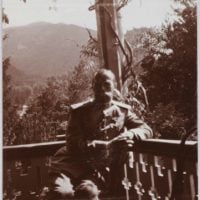
Related

Le Familie Imperial de Russie - Public domain portrait print

A trip of the imperial family to Kozmodemyansk. 1914

Romanovs on vacation in the Crimea. 1909.

Nicholas II, and his family in Livadiya, Crimea

Nicholas II, and his family in Livadiya, Crimea

Imperial family visit the infirmary hospital in the town of Fedorov

Festivities for the coronation of the last Russian Emperor Nicholas II

Nicolas II family visiting Odessa

Romanovs on vacation in the Crimea. 1909.
The Imperial Family| Visit to beloved Crimea for the last time ever
Summary
-How terribly sad it is to leave the Crimea, the sea, the sailors and the ships-
(Grand Duchess Tatiana Nicholaievna, diary entry, on May 16th 1916.)
After short visiting Sebastopol, and attending the Black Sea Parade, IF, accompanied with servants and friends, moved to the city of Evpatoria, by the train. One of the main targets was the opening the Military Hospital of Empress Alexandra Feodorvna. Anna Vyrubova remembers that meeting in the city was the most beautiful, and all bathed in the southern Sun.
Imperial Train arrived at 10 o clock in the morning. After being wholeheartedly welcomed, the IF listened to the speech of the Governor, and then went to the Orthodox Church, where Church Service/Liturgy was served. Directly from Orthodox Temple, the IF proceeded to the Juma mosque, to be welcomed by Muslim community. Next to come, was arrival of IF to Karaite Kenasa and main Jewish synagogue in Evpatoria.
After paying tribute to three main Faiths, Empress Alexandra opened new Hospital named after her. Nicholas, Alexandra and daughters greeted soldiers and wounded people.
After official part of visit, Nicholas went with the Heir at the beach. Alexei played in warm sand, collected shells, built a tower, while Tsar kept neglecting people who followed them. Anna Vyrubova and Rita Khitrovo were presented too. Later, Tsar awarded some soldiers with medals, and Tsarina did some photos. At 6 oclock, with anthem God save the Tsar sung, Imperial Train left the Railroad Station.
Chronologically along with the Russian captions, translated :
0:05 to 0:21 It is 10 o clock. Alexei is seeking out of window, and IF is prepared to go out from the train.
0:22 to 0:42 IH leave Railroad Station
0:43 to 2:32 IH visit Orthodox Church
2:33 to 3:16 - IH visit Mosque
3:17 to 4:20 - IH visit Karaimska Kenassa
4:21 to 4:54 -Visiting Lazaret/Hospital of Empress Alexandra.
+ Nicholas reviewing army on horseback.
-----------------
In the end, I used some photos taken at Evpatorias beach on the same day, we can see GD Olga with her close friend, Margarita Khitrovo, Alexei in the Black Sea, and so.
By this little tribute, I wanted to pay honor to the IF, and to their last visit to Crimea, the place they adored, where they spent some so-called, happier days, and when they were off from every days burdens. Pity that they couldn't see Livadia once more.
Notification : This is purely fan video, not ANY copyright violation intended. As well as for the music, I used an extract from Shostakovich s Concert. ALL material belong to their rightful, respected owners.
There were special court cameramen and photographers who captured the daily life of the Romanov family. The Company of von Gun filmed the Tsar, and with the permission of the Ministry of the Court, showed these films in movie theatres beginning in 1907. Before the February 1917 Revolution, the von Gun Company was the main provider of the Tsar's chronicles in the Russian film industry. After 1907 other filmmakers were permitted to film the Royal family, including A. Drankov, V. Bulla (the elder), Khanzhonkov Company, Pate Company, and others. Before the beginning of World War I a newsreel became popular capturing military parades, holidays, reviews and drills. Many are devoted to the Fleet. They document everyday life of the Baltic Sea and Black Sea squadrons. Some of the newsreels document the fire of the Maly Theatre in Moscow, mass gymnastics, auto and motor races, zoos and animal preserves, and the life of peoples of the Russian Empire. The objects of filming were political and cultural figures, the construction of warships, the Moscow flood, the testing of new agricultural equipment and the oil industry in Baku. There are also films showing the towns of Russia, etc. During World War I, cameramen captured events on all fronts. Before 1915, the exclusive rights to film battles belonged to the Film Department of the Skobelev Committee. The Skobelev Committee of the Assistance to the Wounded Soldiers of the General Staff was founded in November 1904 as a public organization. By the order of the Scobelev Committee many cameramen filmed the events of the World War I, such as Englishman Arcol (representative of Pate Company, filmed on South-Western and Caucasus fronts), cameramen E.D. Dored (represented American companies) and P.V. Ermolov, (filmed events on Caucasus front); P.K. Novitskiy (Gomount Company), N.M. Toporkov, K.E. von Gan, A.K. Gan-Jagelskiy, made filming in the General Headquarters. Other cameramen such as: A. G Lemberg, S, Zebel, Trushe, etc. also worked at the fronts. Cameramen filmed the war not only on the fronts but also from the rear. Since the first month of the war until 1917 the Scobelev Committee produced about 70 newsreels. From 1914 to 1915 cameramen of the Scobelev Committee produced 21 series of the newsreel "Russian Military Chronicle". The materials of this newsreel were used many times for the separate films made by Scobelev Committee and other film companies. Read more at: http://www.pbs.org/redfiles/rao/archives/rgakfd/textind10.html
